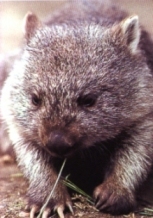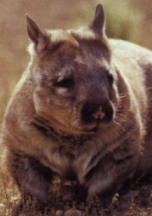WOMBAT
The wombat is a hairy marsupial mammal. It can weigh up to 39 kg and be approximately 1 metre long having a short 25mm tail and stumpy legs.
Wombats like to live alone in hilly forest country and have their own feeding grounds. They like to burrow underground. A burrow can be as long as 20 metres. Sometimes burrows can also interconnect.
Wombats are nocturnal animals who eat grasses, roots and herbs after it gets dark. Sometimes, when they stray out onto the roads at night they are blinded by the lights of oncoming vehicles and the poor wombat just freezes and if the driver doesn't notice it is killed.
|
COMMON
WOMBAT
|
|
 |
The
size of a large, stocky dog, the Common Wombat lives in forested
ranges, from north-eastern NSW to south-eastern SA. The Common Womabt
is a ground living burrower with grey to brown, coarse fur. Its
outline is rounded and it has a large head and short ears. Wombats are active at night and during sunny winter days. They eat native grasses, shrubs and roots. Each Wombat lives alone but the burrows it digs may connect with those of other wombats. A big burrow may be up to 20 metres long with several chambers and entrances. A female carries 1 young in her rear opening pouch for 6 months. It follows her for another 11 months. The Wombat is not protected in some areas of eastern Victoria. |
|
SOUTHERN
HAIRY-NOSED WOMBAT
|
|
 |
The
rare and endangered Southern Hairy-nosed Wombat is found only in
the desert bordering the Great Australian Bight in SA. It is a bulky, ground living marsupial with soft, silky brown fur. The fur on its nose is white. This wombat rarely gets water to drink. When it rests in its burrow, its body functions slow down to save energy and water. At night the wombat eats native grasses. Several wombats may share a network of burrows. A female Hairy-nosed Wombat carries 1 young in her rear opening pouch for up to 9 months. It is weaned at 12 months. Three years of good rain are needed to grow enough grass for a young one to be weaned. |
| BACK TO MAMMALS |
| mammals | | | birds | | | reptiles | | | spiders |